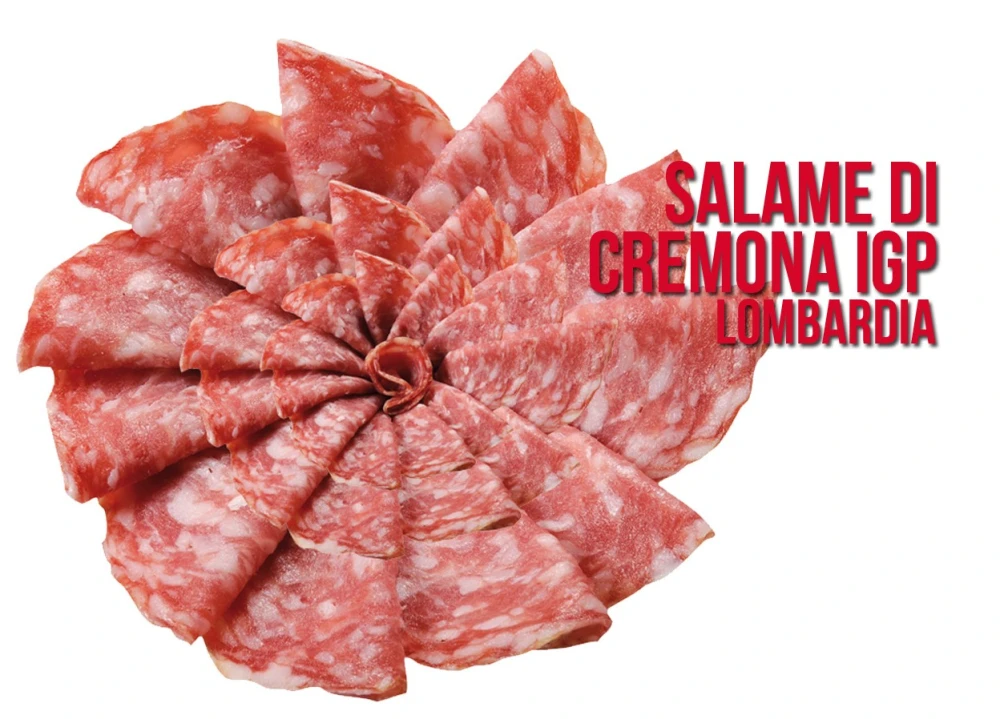Its precise origins are unclear, but salami making has certainly been closely associated with the presence of numerous pig farms in the Po Valley since Roman times. Pig farming and the marketing of pork products acquired a central role in the rural economy and the daily life of the local communities at that time, a fact testified by numerous codex decorations depicting scenes of pig farming and slaughtering during the autumn months.
There are numerous references to the presence of salami in this area since the 13th century, such as the frieze of the labours of November on the facade of Cremona Cathedral, which shows a pig being slaughtered, and some notarial deeds for the sale of pigs from Cremona to neighbouring states.
The establishment of salami in the Cremona area is verified in the 'Annales' of the Notary Ludovico Cavitelli, from 1583, which describe how some of the local inhabitants made a kind of sausage from pork that was minced, mixed with pepper, ginger and cinnamon, stuffed into animal intestines, tied and then boiled or roasted.
Cremona salami was aptly named 'salsicciotto' (lit.: 'large sausage'), because it could be eaten fresh, boiled or roasted. Documents from the 16th century indicate that the salami was distributed to convents and was known and appreciated by the nobility of the time, even beyond the territory of Cremona. A document from 1853 describes the Cremonese as inventors of several varieties of appetising and profitable salamis, and mentions the large number of pigs slaughtered each year for their production. The original need to cure pork during the autumn and winter months to provide nutritional food for the spring and summer months led to the development of new systems and methods.
It was only after World War II, however, that the cured meat sector adopted the benefits of new technologies: the introduction of refrigeration techniques and the invention of air and humidity conditioning brought a true revolution and allowed the manufacturers to produce salami throughout the year.
Salami production soared between the 1950s and '60s, when the Italian economic boom was at its height, driven by the significant increase in consumption due to the lower production costs permitted by year-round manufacturing.
Over the last half century, “Salame Cremona IGP” has become increasingly characterised as a factory-made product, although several companies still make salami by hand. However, the manufacturing methods, which are regulated by the product specifications, are the same for both industrial plants and hand-made production.
Although they have evolved over time, the preparation, processing and curing of PGI Cremona Salami are still based on the same original principles, passed down from generation to generation to the present day. This has allowed the product to preserve the special organoleptic qualities that clearly distinguish it from other Italian salamis.
The Product
PGI Cremona Salami is made from selected pork that is ground, seasoned with salt and crushed garlic and stuffed into natural casings. The specifications require the exclusive use of pork from Italian pigs reared in the Prosciutto di Parma and Prosciutto di San Daniele production areas.
Only fresh meat may be used for the preparation of PGI Cremona Salami. The salami is left to cure for a minimum of five weeks for the smallest size, to over four months for the largest, and its characteristic features of softness and doughiness remain unchanged.
Thanks to its perfect blend of ingredients, PGI Cremona Salami is particularly aromatic and spicy on the palate, with a fragrant aroma and an intense red colour that gradually blends with the white fatty parts. The product has a cylindrical shape with slight irregular sections and a soft texture. The slices are compact and homogeneous.
The local area
Today, the PGI Cremona Salami production area includes the regions of Lombardy, Piedmont, Emilia Romagna and Veneto. The original production area, which was marked by the borders of the province of Cremona during the Lombard era, gradually extended until, by the mid-19th century, the area involved included almost the entire basin of the Po valley and the adjacent Alpine and Apennines valleys.
The landscape of the Po Valley is uniform and completely flat, traversed by various rivers and canals and mainly used for corn growing, with woody vegetation limited to fruit trees or isolated poplar groves. In the Apennine valleys, despite the great variations in the overall landscape, very similar physical and climatic characteristics are found, especially near the water courses on the valley floors.
All of these areas have a similar high level of humidity and relatively little wind, with severe autumns and winters that are damp and foggy, mild, rainy springs and warm summers with frequent showers. These characteristics have favoured the development of pig farming. The damp climate, with little wind, also provides the ideal conditions for curing the product.
By Consorzio di Tutela del Salame Cremona with MiPAAF




